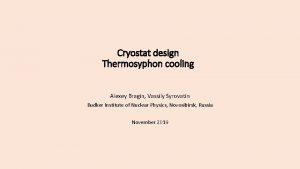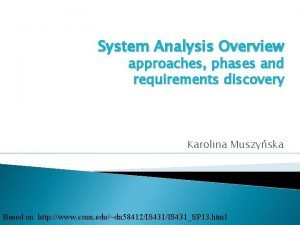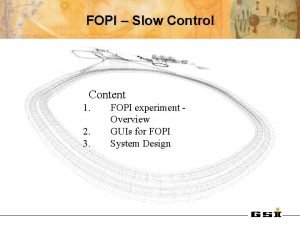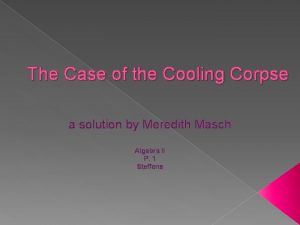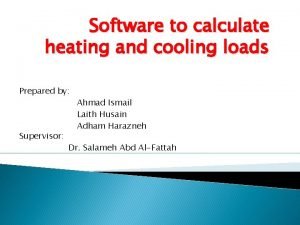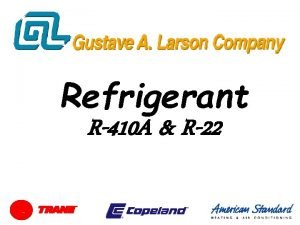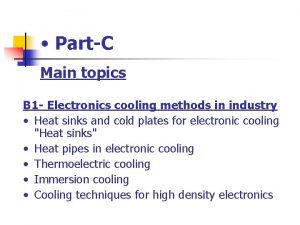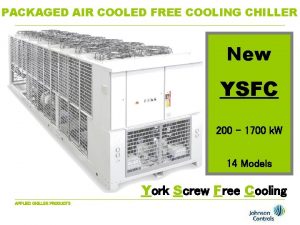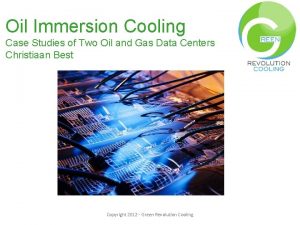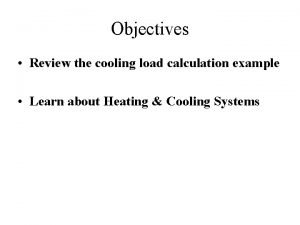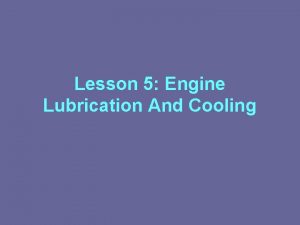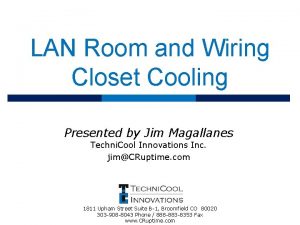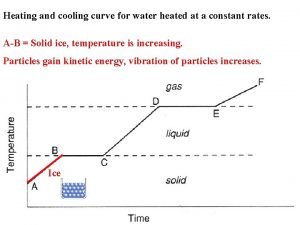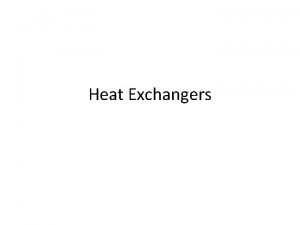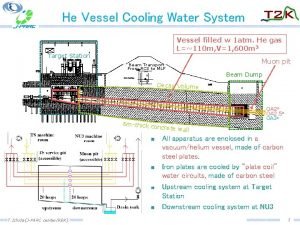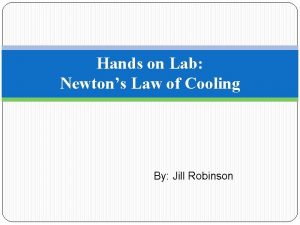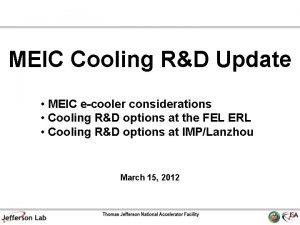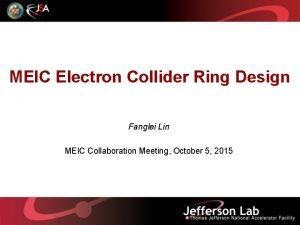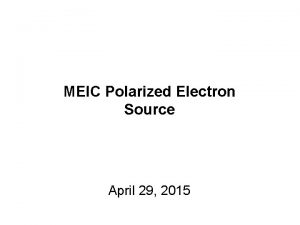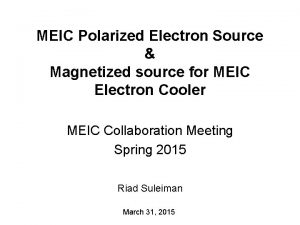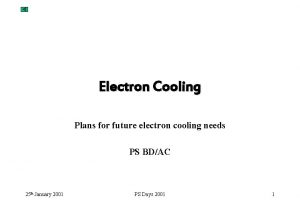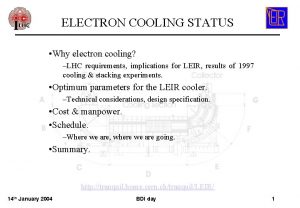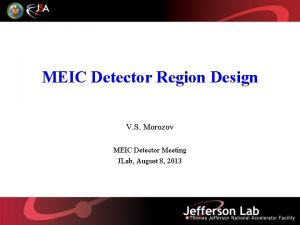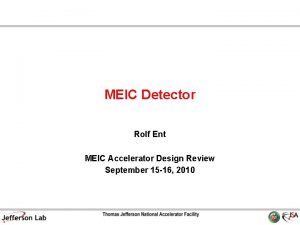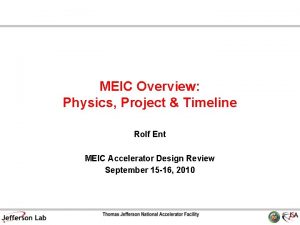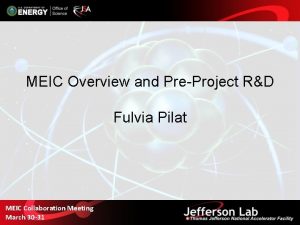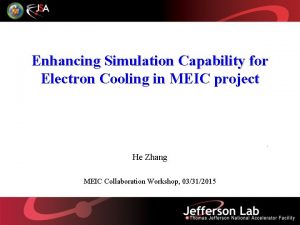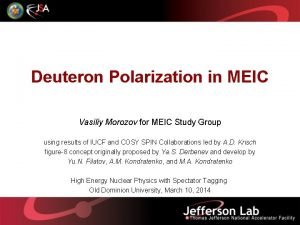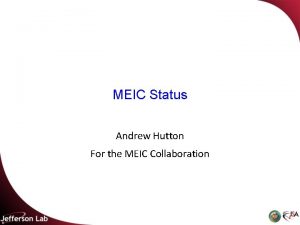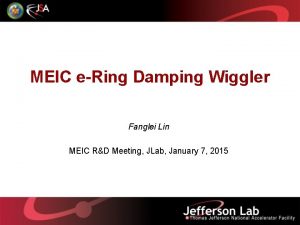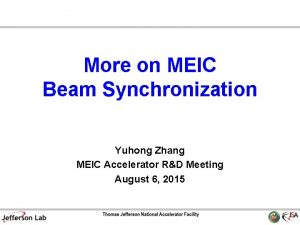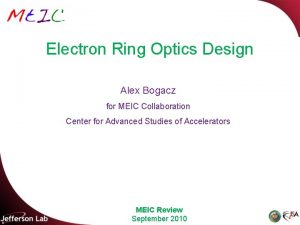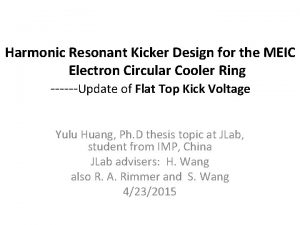MEIC Electron Cooling Overview of MEIC Cooling Design




















- Slides: 20

MEIC Electron Cooling Overview of MEIC Cooling Design Yuhong Zhang MEIC Collaboration Meeting Spring 2015 March 30 and 31, 2015

Outline Introduction MEIC Electron Cooling Scheme DC Cooling Bunched Beam Cooler Design Summary 2

Introduction MEIC relies on conventional electron cooling for delivering high luminosities MEIC has adopted a multi-step cooling scheme, utilizes a DC cooler in the booster ring and a high energy cooler with a bunched electron beam in the collider ring A design concept has been developed for a bunched beam electron cooler based an ERL. This cooler is sufficient for the present MEIC baseline An ultimate cooler design include a circulator ring that will help to deliver an 1+ A current cooling electron beam; it supports a luminosity upgrade (exceeding 1034 cm-2 s-1) 3

Multi-Step Cooling for High Performance Cooling of the MEIC protons/ions • achieves a small emittance • achieves a short bunch length of 1 to 2 cm (with strong SRF) • enables ultra strong final focusing and crab crossing • suppresses intra-beam scatterings (IBS), maintaining beam emittance • expands luminosity lifetime MEIC adopts conventional electron cooling • Well established technology (in the low energy DC regime) Multi-step scheme • taking advantages of high cooling efficiency at low energy or/and with small emittance 4

MEIC Multi-Step Cooling Scheme ion linac ion sources BB cooler DC cooler collider ring (8 to 100 Ge. V) Booster (0. 285 to 8 Ge. V) Ring Booster Cooler DC Function Ion energy Electron energy Ge. V/u Me. V 0. 11 ~ 0. 19 (injection) 0. 062 ~ 0. 1 2 1. 1 Maintain emittance during stacking 7. 9 (injection) 4. 3 Maintain emittance Up to 100 Up to 55 Injection/accumulation of positive ions Emittance reduction Collider Bunched Beam (BB) DC cooling for emittance reduction BB (bunched beam) cooling for emittance preservation We anticipate up to 2 orders of magnitude increase of combined cooling rate 5

MEIC DC Cooler: Within State-of-Art Design specifications • • Magnetized beam Energy range: 0. 11 to 1. 1 Me. V Electron current: 2 A Cooling section: 10 m Present status of technology We plan to collaborate with Budker Institute to adopt this cooler design for MEIC • Well developed and low cost, • The most recent experience is a 2 Me. V cooler for COSY built by Budker Institute recently successfully commissioned COSY Parameter Unit Value Energy range Me. V 0. 1 to 2 High voltage stability COSY, IKP, Jülich < 10 -4 Electron current A 0. 1 to 2 Cooling section length m 2. 69 Solenoid field (cooling section) k. G 0. 5 to 2 Electron beam diameter cm 1~3 Toroid radius m 1

Bunched Beam Cooler: Baseline & Ultimate For the present baseline, the designed emittance (0. 5 to 1 mm mrad) leads to a much longer IBS growth time, thus requiring a significantly lower electron current In an anticipated design optimization (or as an option of future luminosity upgrade), we need a higher electron current Present baseline Ultimate Me. V up to 55 A / n. C 0. 2 / 0. 42 1. 5 / 3. 15 MHz 476 Cooling section length m 60 60 RMS Bunch length cm 2 2 Electron energy spread 10 -4 3 3 T 2 2 Normalized drift emittance mm mrad 586. 3 Normalized Larmor emittance mm mrad 1. 5 Normalized transverse emittance mm mrad 29. 7 Electron energy Beam Current and bunch charge Bunch repetition Cooling section solenoid field 7

Bunched Beam Cooler Design Concept Utilizes energy-recovery-linac (ERL) (the beam power is up to 11 MW) Cooling by a bunched electron beam Cooling section bunch circulations 25+ Kicker rep rate MHz 19. 05 Kick duration ns 2. 1 Angle electron bunch solenoid mrad Ultra fast kicker energy recovery SRF Linac injector dump 8

Present Status ERL cooler design concept Seems no (? ) alternative solution that does not compromise the performance Has a long history (HERA upgrade@1990 s, RHIC/e. RHIC@early 2000 s) Technologies (high current e-source, ERL etc. ) advanced rapidly, however, are still significantly below what are required. Technical design Down-selection of non-magnetized and magnetized beam for cooling Developed a high level parameter set (based on cooling simulation and beam matching in the cooling section) Some initial attempt had been made (circulator ring lattice) Beam physics studies Some initial studies of CSR-micro-bunching instabilities Technology development Some ideas on fast kickers

The 1 st Design Attempt of ERL-Circulator Cooler D. Douglas, C. Tennant decompression er irp ch de dump Circulator Cooler Ring cooling solenoids Magnetized source rec hir pe r SRF injector ERL beam exchange system recompression Advanced design elements Magnetized electron beam/source Round-to-flat transform Energy at injection/dump Accelerator technologies High current electron source Ultra fast kicker Full energy Me. V 5/5. 3 Long. emitt. at injection ke. V-ps 80 RMS length @ injection ps 5 Me. V 54 Acceleration/recovery phase RMS bunch length at CCR 10 -13/166º cm 1~3

Preliminary Study of Beam Dynamics In a Circulator Ring Particle tracking (Elegant) simulations of an electron bunch in the circulator cooler ring 2 n. C, • 0. 5 -- 2 n. C bunch charge (2 n. C design value) After 10 turns • 1 -- 3 cm bunch length (3 cm design value) • < 0. 1% energy spread (5 x 10 -4 design value) 1 cm 2 cm Factors limiting number of circulations in CCR • Beam quality degradation by intra/inter beam scatterings • Space charge • Micro-bunching instabilities Coherent synchrotron radiation (CSR) could induce micro-bunching instabilities, 3 cm 0. 5 n. C, 3 cm. 100 turns CSR mitigation Δp/p~10 -4 • Magnetized beam (Ya. Derbenev) (it also suppresses space charge effect) • Shielding in beam pipe • Optical management (D. Douglas) (Using longitudinal periodic achromat, simulations show little to no micro-bunching ) Δp/p~9 x 10 -4 11 E. Nissen, C. Tennant

Proposed Experimental Demonstration of Cooling with a Bunched Electron Beam A collaboration of JLab, IMP (China) and BINP (Russia) currently under discussion Cooling by a bunched electron beam is considered one (remaining) critical R&D for the MEIC present baseline IMP has two storage rings, each has a DC cooler for ion coasting beams (built in collaboration with BINP, Russia) Idea: modulating a DC electron beam into a bunched beam with a high repetition rate by applying a pulsed voltage to the bias-electrode of the electron gun Non-invasive experiment, supported by IMP leadership A pilot study supported by a JLab LDRD in progress A. Hutton (JLab) H. Zhao (IMP) Institute of Modern Physics (IMP), Chinese Academy of Science (CAS) BNL Le. Re. C program also utilizes a BB e-cooler DC cooler 12 Slide 12

Ultra Fast Kicker RF kicker • Like an RF separator, a strip-line kicker driven by a waveform which is a superposition of multi harmonic waveforms • Requires a multi-harmonic signal amplifier A. Kimber 1, 5 1 Beam-beam kicker 0, 5 F surface charge density D 0 -10 v≈c -1 kicking beam L 0 -0, 5 h σc -5 v 0 V. Shiltsev, NIM 1996 5 10

Path Forward The MEIC bunched beam electron cooler study urgently needs a big boost For reaching a CD 1 in two years A technical (front-to-end) design of an ERL cooler is a must Significant progress in the beam physics studies Development (and hopefully proof-of-principle) of key technologies Technology R&D 200 m. A current magnetized electron source High current ERL Mitigating the beam instabilities (micro-bunching) Cooling simulation How to validate the simulation?

LDRD and SBIR for Cooler R&D For the present MEIC baseline design • Experiential demo of cooling of ions by a bunched electron beam (LDRD) • Cooling simulations (SBIR) • Cooling software development (LDRD) For achieving luminosity above 1034 cm-2 s-1 • Improvement of cooling simulation (including code development LDRD) • Development of an RF based fast kicker (LDRD) • Development of high bunch charge/current magnetized electron source • (SBIR and pending LDRD) Demonstration of mitigation of coherent synchrotron radiation/microbunching instability (LDRD) 15

Acknowledgement The MEIC accelerator design study group, particularly, for those participated electron cooling studies Yaroslav Derbenev David Douglas, Rongli Geng, Jiquan Guo, Andrew Hutton, Andrew Kimber, Rui Li, John Musson, Matt Poelker, Robert Rimmer, Yves Roblin, Riad Suleimen, Chris Tennant, Cheng-yin Tsai, Amy Sy, Haipeng Wang, Shaoheng Wang, He Zhang (Jefferson Lab) Edward Nissen (CERN) Hongwei Zhao and Lijun Mao (IMP, China) George Bell and Ilya Pogorelov (Tech-X) Takeshi Katayama (U. Tokyo) Peter Mc. Intyre (Texas A & M Univ. ) 16

Backup slides 17

Circulator Ring for Higher Current/Luminosity To reach luminosities beyond the present baseline (>1034 cm-2 s-1) Requires much smaller emittance (0. 35 and 0. 07 mm mrad) Requires much higher electron current for cooling, ~1. 5 A (bunch charge 3. 15 n. C) A circulator ring will reuse the bunches 25 times, thus, reduce the current from the electron source/injector by a same factor Beyond state-of-the-art Require a ultra-fast kicker to switch the bunches in and out of the cooler ring Require a high bunch charge (~3. 15 n. C) electron source/injector Must suppress the collective instabilities Bunch revolutions ion bunch Cooling section Fast kicker injector solenoid circulator ring energy recovery SRF Linac electron bunch Fast kicker ~25 in CCR Current in CCR/ERL A 1. 5/0. 06 Electrons/bunch 1010 1. 25 Bunch repetition rate in CCR/ERL MHz 476/30 recirculating 25+ turns dump reduction of current from an ERL by a same factor 18

Proposed Beam Studies and Technology Development for an ERL-Circulator Cooler Dechirper Rechirper Cooler Test Facility @ JLab FEL ERL New Beam-line § Demonstrate the cooler design concept § Develop/test key technologies (magnetized gun, fast kickers, etc. ) § Study dynamics of the cooling bunches in a circulator ring § Using the existing ERL without upgrade, adding two 180°dipoles (available at JLab) § Supporting MEIC to deliver the high luminosity (1034 1/cm 2/s), 19

High Current Un-polarized Electron Gun We propose a three-gun injector, based on the CEBAF injector success Beam current: 3 x 67 ~ 200 m. A (Cornell, 60 m. A) Bunch charge: 0. 42 n. C, very comfortable for a DC/RF photo-cathode gun Gun Steering (BPMs/kickers) Beams from three individual guns RF recombiner dipole All existing/demonstrated technologies Solenoids (emittance compensation) collimation CEBAF injector Chopper cavity Polarized DC gun One beam dipole Master slit buncher Master A slit Chopper cavity Three beam One beam 20 One beam B C
 Thermosyphon cooling system design
Thermosyphon cooling system design System design
System design System design overview
System design overview Case of the cooling corpse answer
Case of the cooling corpse answer Liz owns stock in nar
Liz owns stock in nar Estimating air conditioning load software
Estimating air conditioning load software R410a pressure chart
R410a pressure chart Electronic cooling methods
Electronic cooling methods Free cooling chiller
Free cooling chiller Immersion cooling case
Immersion cooling case Ocp liquid cooling
Ocp liquid cooling Heating and cooling load calculation example
Heating and cooling load calculation example Engine lubrication and cooling system
Engine lubrication and cooling system Lan room
Lan room Standard refrigeration heat exchanger
Standard refrigeration heat exchanger His cart might be a flower bed
His cart might be a flower bed Cooling curve labeled
Cooling curve labeled Cooling equipment heat exchanger
Cooling equipment heat exchanger Vessel cooling
Vessel cooling Site:slidetodoc.com
Site:slidetodoc.com Denco cooling units
Denco cooling units
